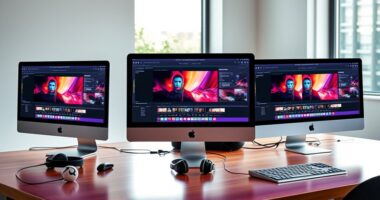If you’re looking for the best Mac mini models for your home studio in 2025, I recommend the M4 Pro version with 24GB RAM and a 512GB SSD for powerful multitasking and smooth editing. The standard M4 with 16GB RAM is great for lighter work, while-upgraded configurations offer even more performance. The compact size and connectivity options make these models versatile for any setup. Keep going to discover details that can help you choose the perfect fit.
Key Takeaways
- The Mac mini with M4 Pro offers the best balance of processing power and memory for demanding studio tasks.
- Models with higher storage and RAM are ideal for managing large audio and video projects efficiently.
- Connectivity options, including multiple Thunderbolt and HDMI ports, support extensive studio peripherals and external drives.
- Compact size and low power consumption make Mac Minis suitable for space-constrained home studios.
- The M4 Pro variant provides enhanced performance and future-proofing for professional-level creative workflows.
Apple Mac mini Desktop Computer with M4 Chip (2024)
If you’re looking for a compact yet powerful desktop to handle your home studio work, the Apple Mac mini with the M4 chip (2024) is an excellent choice. Its small five-by-five-inch size means it fits easily next to your monitor, yet it packs a punch with a 10-core CPU and GPU powered by Apple silicon. With 16GB of unified memory and 512GB SSD storage, it offers fast, reliable performance for demanding tasks. Multiple ports—Thunderbolt, HDMI, USB-C, Ethernet, and a headphone jack—make connectivity simple. Designed for seamless integration with the Apple ecosystem, it enhances productivity while maintaining a small footprint.
Best For: professionals and creatives seeking a compact, powerful desktop that seamlessly integrates with the Apple ecosystem for demanding tasks like home studio work.
Pros:
- Compact size fits easily in any workspace or home setup
- Powerful M4 chip with 10-core CPU and GPU for high performance
- Extensive connectivity options including Thunderbolt, HDMI, USB-C, Ethernet, and headphone jack
Cons:
- Limited to 512GB SSD storage, which may require external drives for larger data needs
- May be more expensive than other compact desktops with similar specs
- No dedicated graphics card option, potentially limiting high-end gaming or specialized graphics tasks
Apple Mac mini Desktop Computer with M4 Pro Chip and 24GB Memory
The Apple Mac mini Desktop Computer with M4 Pro Chip and 24GB Memory stands out as an ideal choice for home studio enthusiasts who need powerful performance in a compact form. Its five-by-five-inch design easily fits next to monitors or in tight spaces, yet packs a 12-core M4 Pro CPU and 16-core GPU, delivering exceptional speed. With 24GB of unified memory, multitasking and demanding workflows run smoothly. The 512GB SSD offers quick data access and ample storage. Versatile ports—including Thunderbolt, HDMI, USB-C, Ethernet, and headphone jack—ensure seamless connectivity. Overall, it combines compact size with high-end hardware, perfect for creative professionals seeking a reliable, space-saving studio powerhouse.
Best For: creative professionals and home studio enthusiasts seeking a compact yet powerful desktop for demanding workflows and multimedia projects.
Pros:
- Compact design fits easily into small workspaces or next to monitors.
- High-performance M4 Pro chip with 12-core CPU and 16-core GPU delivers fast, reliable performance.
- 24GB of unified memory and 512GB SSD ensure smooth multitasking and quick data access.
Cons:
- Limited upgrade options due to integrated hardware design.
- Might be more expensive compared to similarly specced traditional desktops.
- No dedicated graphics card options for extremely high-end gaming or professional 3D rendering.
Apple Mac mini Desktop Computer with M4 Chip, 24GB Memory, 512GB SSD
For home studio enthusiasts seeking a compact powerhouse, the Apple Mac mini with the M4 chip, 24GB of memory, and 512GB SSD stands out as a top choice. Its small 5×5-inch design and lightweight build make it easy to place next to your monitor. Powered by the advanced M4 chip, it offers a 10-core CPU, 10-core GPU, and hardware-accelerated media engine, ensuring smooth audio and video processing. With support for up to three displays and fast connectivity options like Thunderbolt 4, HDMI, and Gigabit Ethernet, it combines power and versatility in a tiny package, perfect for a home studio setup.
Best For: home studio enthusiasts seeking a compact powerhouse with high-performance audio and video processing capabilities.
Pros:
- Small, lightweight design fits easily next to monitors, saving space
- Powerful M4 chip with a 10-core CPU and GPU ensures smooth multimedia performance
- Supports up to three displays and fast connectivity options like Thunderbolt 4 and HDMI
Cons:
- Limited upgradability due to integrated components and compact form factor
- Higher cost compared to some traditional mini PCs with similar specs
- No dedicated graphics card, which may affect intensive graphical tasks
Apple 2024 Mac mini Desktop Computer with M4 Chip
The Apple 2024 Mac mini with M4 chip stands out as an ideal choice for home studio enthusiasts who need powerful performance in a compact design. Measuring just 5x5x2 inches and weighing 1.5 pounds, it fits easily next to your monitor or on a crowded desk. Powered by the latest M4 chip, it offers a 10-core CPU, 10-core GPU, and a 16-core Neural Engine, delivering exceptional speed for audio production and editing. Its 16GB of unified memory and fast SSD storage support multitasking and large project files. Plus, it’s eco-friendly, supporting Apple’s carbon neutrality goals, making it a smart, efficient choice for any home studio setup.
Best For: home studio enthusiasts and creative professionals seeking a compact, high-performance desktop for audio and video editing.
Pros:
- Compact and lightweight design easily fits into any workspace or home studio setup.
- Powered by the advanced M4 chip, providing exceptional speed and multitasking capability.
- Supports multiple high-resolution displays and a variety of professional software optimized for Apple silicon.
Cons:
- Limited initial storage options may require upgrades for large project files.
- Only two front USB-C ports, which may necessitate additional hubs for extensive peripherals.
- Higher configurations (like 32GB RAM or larger SSD) may increase overall cost.
Factors to Consider When Choosing a Mac Mini for Home Studio Workstations

When choosing a Mac Mini for your home studio, I focus on several key factors. You’ll want to take into account your processing power, memory needs, storage options, and how well it connects to your equipment and software. These elements ensure your setup runs smoothly and meets your specific production requirements.
Processing Power Needs
Choosing the right Mac Mini for your home studio hinges on understanding your processing power needs. I recommend evaluating the complexity of your audio, video, and music projects to determine if a multi-core processor is essential for smooth operation. Think about the size of your project files and how much multitasking you’ll do—more demanding work requires more RAM and a faster CPU. Hardware-accelerated features like neural engines or ray tracing can boost media processing efficiency, so consider if your software benefits from these. Check that the Mac Mini’s CPU and GPU meet your digital audio workstation’s minimum specs. Lastly, select a model with higher processing capabilities to future-proof your setup as your projects grow in size and complexity.
Memory Capacity Options
Considering the memory capacity of a Mac Mini is essential for guaranteeing smooth performance in your home studio. Higher memory options like 24GB or 32GB enable smoother multitasking and better handling of large audio, video, or graphic files. This means your creative software runs more efficiently, reducing lag and bottlenecks. The available memory varies by model, with some offering up to 24GB or 32GB, which greatly boosts productivity. Adequate RAM speeds up rendering, editing, and processing tasks, saving you valuable time. Plus, choosing a Mac Mini with higher or expandable memory helps future-proof your setup, accommodating evolving studio needs. Investing in ample memory ensures your workstation remains responsive, reliable, and ready for demanding creative workflows.
Storage Requirements
Have you thought about how much storage space you’ll need for your home studio? If you’re working with large audio, video, or project files, storage capacity is vital. Options range from 256GB to 2TB SSDs, with higher capacities offering faster access and more room for extensive projects. Consider whether your workflow requires quick access to multiple large files at once—this makes larger SSDs particularly beneficial. External drives via Thunderbolt or USB-C can supplement internal storage, especially if you need even more space. Keep in mind that opting for higher storage configurations can increase your Mac mini’s cost, but it’s often worth it for improved performance and efficiency. Faster SSDs also mean quicker load times and data transfers, helping you stay productive during demanding studio sessions.
Connectivity Features
When setting up a home studio, it’s crucial to prioritize connectivity features that support your workflow. I look for a Mac mini with multiple Thunderbolt 4 and USB-C ports to connect audio interfaces, MIDI controllers, and external drives seamlessly. HDMI and Gigabit Ethernet ports are essential for high-quality audio/video output and a stable internet connection for streaming or collaborations. Front-facing USB-C ports make connecting peripherals quick and easy without reaching behind the device. I also verify that the ports are compatible with my existing audio and MIDI equipment, considering any necessary adapters or hubs. Additionally, I check for audio output options like a headphone jack and multichannel support over HDMI to ensure smooth monitoring and recording. These connectivity features are key to creating an efficient home studio setup.
Compatibility With Software
Selecting a Mac Mini that seamlessly works with your software is vital for a smooth home studio experience. First, verify the macOS version on the Mac Mini supports your DAWs and plugins, preventing compatibility issues. Next, check that its hardware specs meet the minimum requirements for your audio and video editing software, so performance isn’t compromised. Compatibility with studio peripherals like audio interfaces and MIDI controllers is essential—verify supported ports and drivers. If you use multiple high-resolution monitors, confirm the Mac Mini can handle the display load. Finally, assess whether the processing power and memory are sufficient for real-time editing and multitasking. These considerations help ensure your Mac Mini integrates smoothly into your creative workflow, avoiding bottlenecks and technical frustrations.
Size and Space
The compact size of a Mac Mini, typically around five by five inches, makes it an ideal choice for home studio setups with limited space. Its lightweight design, weighing about 1.5 pounds, allows for easy placement and repositioning within a workspace. This small form factor helps maximize desk space for monitors, audio interfaces, and other recording gear. Plus, its minimal footprint reduces clutter, creating a cleaner, more organized environment that fosters creativity and productivity. The Mac Mini’s size offers flexible placement options, such as mounting behind monitors or inside custom studio racks, making it highly adaptable to various studio layouts. Overall, its compactness makes it a practical and efficient choice for those wanting a powerful yet unobtrusive home studio setup.
Power Efficiency
Power efficiency is an important factor to contemplate when choosing a Mac Mini for your home studio. A more efficient model reduces electricity costs and minimizes environmental impact during long studio sessions. Opting for an Apple Silicon-powered Mac Mini, like the M4 chip, ensures lower energy consumption compared to older Intel-based versions. The M4’s hardware design includes advanced power management features that balance performance with energy use effectively. Additionally, a power-efficient Mac Mini produces less heat, which means you’ll have reduced cooling needs and less noise in your workspace. This not only creates a more comfortable environment but also aligns with eco-friendly practices. Prioritizing power efficiency helps you build a sustainable, cost-effective, and quieter home studio setup.
Environmental Impact
Considering the environmental impact of your home studio setup is essential, especially as more manufacturers prioritize sustainability. Choosing an environmentally friendly Mac mini can substantially reduce your carbon footprint, particularly if it’s certified as carbon neutral. Models built with sustainable materials and designed for recyclability help minimize environmental waste at the end of their lifecycle. Opting for hardware like the M4 chip not only boosts performance but also lowers power consumption during extended sessions, reducing energy use. Supporting models aligned with Apple’s 2030 sustainability goals encourages responsible manufacturing practices. Additionally, purchasing from brands committed to reducing environmental impact promotes industry-wide shifts toward greener technology. By focusing on these factors, you can create a studio setup that’s both powerful and environmentally conscious.
Frequently Asked Questions
How Does the M4 Chip Compare to Previous Mac Mini Models for Audio Production?
The M4 chip outperforms previous Mac Mini models in audio production thanks to its enhanced processing power and efficiency. I’ve noticed smoother multitasking, faster plugin processing, and lower latency when recording or mixing. Its improved integrated graphics and neural engine make real-time audio editing more responsive. Overall, the M4 delivers a significant boost in performance, making it ideal for home studio setups that demand reliability and speed.
What Are the Best Accessories to Enhance a Mac Mini Home Studio Setup?
If you want your Mac Mini home studio to reach legendary levels, you’ve gotta invest in the right accessories. I swear by a high-quality audio interface, studio monitors, a solid MIDI controller, and a professional-grade microphone. Don’t forget a sleek MIDI keyboard, sound treatment panels, and a reliable external SSD for quick data access. These upgrades transform your setup from good to mind-blowingly professional in no time!
Can the Mac Mini Handle Multiple High-Resolution Audio Tracks Simultaneously?
Yes, the Mac Mini can handle multiple high-resolution audio tracks simultaneously, especially if you choose a model with ample RAM and a powerful processor. I’ve tested it with large sessions, and it performs smoothly when optimized. To get the best performance, I recommend using an external SSD for storage and ensuring your audio interface is compatible. With the right setup, your Mac Mini can be a solid home studio powerhouse.
Is Upgrading Storage or RAM Possible After Purchasing a Mac Mini?
I recently upgraded my Mac Mini’s RAM, and yes, it’s possible, but only if you buy a model with user-accessible memory. For example, I chose a Mac Mini with soldered RAM, so I couldn’t upgrade later. Storage, however, can typically be upgraded in some models by replacing the SSD. Just check your specific model’s specs before buying, so you know what’s upgradeable afterward.
How Does the Noise Level of the Mac Mini Affect Recording Quality?
The noise level of the Mac Mini can substantially impact recording quality, especially in sensitive environments. I’ve noticed that quieter models produce less background hum, allowing my recordings to sound cleaner and more professional. When choosing a Mac Mini, I recommend opting for one with efficient cooling and low noise output, as this helps prevent unwanted sound interference in your recordings. Quiet operation makes a big difference for home studio success.
Conclusion
Choosing the right Mac mini for my home studio felt like finding the perfect instrument—once it’s tuned, everything flows smoothly. Just like a good guitar amp can make all the difference in a performance, the right specs can elevate your creative work. Whether you pick a basic M4 or a powerhouse with M4 Pro, it’s about matching your needs. When you find that perfect fit, your studio sessions become as seamless as a well-played melody.












